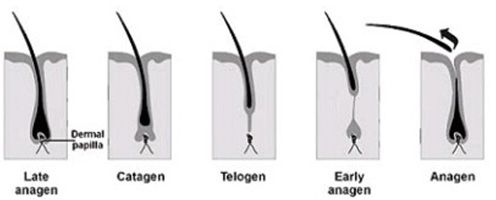I know many of us are often concerned about the amount of shed hair that we see, me included! And, we’ve probably all heard that shedding 50-100 hairs a day is normal. And, we know that most of the hairs we are seeing are shed and not broken, because we see and/or feel the bulb on one end of the strand.
But, despite all that, when we see those strands falling free on days that we wear our hair down (hand in hair syndrome, also known as HIH, is often an accomplice”> and see that hair ball getting bigger on wash day as strands litter the bathroom floor, shower walls and drain, it can be unnerving and anxiety-inducing.
And, when I become concerned about my hair, I put on my research cap and try to understand what is happening. Hopefully, what I’ve learned will be of benefit to others! So, here is a little information about the three phases of the hair life cycle.
The 3 phases of the hair life cycle
Anagen Phase – Growth Phase
Approximately 85% of all hairs are in the growing phase at any one time. The Anagen phase or growth phase can vary from two to six years. Hair grows approximately 10cm per year and any individual hair is unlikely to grow more than one meter long.
Catagen Phase – Transitional Phase
At the end of the Anagen phase the hairs enters into a Catagen phase which lasts about one or two weeks, during the Catagen phase the hair follicle shrinks to about 1/6 of the normal length. The lower part is destroyed and the dermal papilla breaks away to rest below.
Telogen Phase – Resting Phase
The resting phase follows the catagen phase and normally lasts about 5-6 weeks. During this time the hair does not grow but stays attached to the follicle while the dermal papilla stays in a resting phase below. Approximately 10-15 percent of all hairs are in this phase at an one time.
[W]hat many people do not know is that the widely quoted scientific figure is in fact based on 2-3 small scale studies which account for as few as 2 individuals. There are in fact no studies which actually track a reasonable group of individuals over a period of years to firmly determine how long the hair growth cycle actually is.
Furthermore there is evidence that this 2-6 year widely accepted length could be considerably wrong. One interesting study which measured hair length of visitors to US theme parks and hair lengths recorded online on long hair sites, came to the conclusion that the average normal length of the anagen phase could be as long as 12 to 14 years.
How dense is your hair?
The more strands of hair that you have on your head, the more hair that you can expect to shed given that 10-15% of your hair is in the telogen phase at any given time. I even notice that the denser left side of my head sheds more than the right side. (Check out this article on CurlyNikk.com if you’re not certain how to determine your hair density.”>
How long is your hair?
As your hair gets longer, it can create the “optical illusion” that your shedding is increasing. But remember, the same number of hairs that you shed when your hair is shorter will appear like more hair the longer that your hair gets. Ten waist length hairs are going to look like a lot more hair than ten TWA hairs.
Is the volume of your shedding consistent?
If you’re like me, you never paid too much attention to your shedding until you started a “healthy hair journey.” You have only a vague recollection of how much your hair shed as it didn’t really concern you. Then, you discovered natural hair online. Goodness. LOL!! But, even if you don’t know what your hair shed looked like previously, evaluating it at consistent intervals can allow you to determine whether it’s increasing, decreasing or remaining constant. Some ladies go as far as counting their shed hairs and/or placing them in a baggie to compare from week to week. That would drive me crazy. So, I just look at the size of my hair ball and try to make certain it looks relatively the same from week to week on wash day.
Are internal or external factors affecting your shedding rate?
As many know, pregnancy hormones can cause the hair to “stick” in the anagen phase, resulting in longer, fuller, thicker hair. A few months after having a baby, all the hair that got “stuck” in the growing phase during pregnancy gets “unstuck” and shedding can decrease dramatically, resulting in bald spots. Hormonal changes due to the aging process can also cause an increase in shedding. Stress can cause excessive shedding as can nutritional deficiencies. Finally, a product that “disagrees” with your scalp and causes irritation can cause shedding above normal rates (e.g. Amla caused me to have a horrible bout of shedding for months”>.


